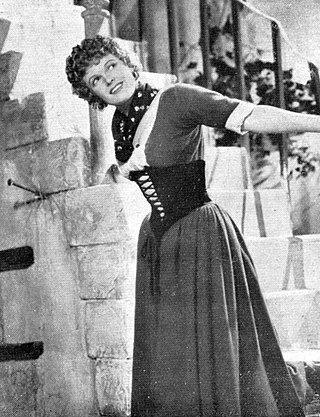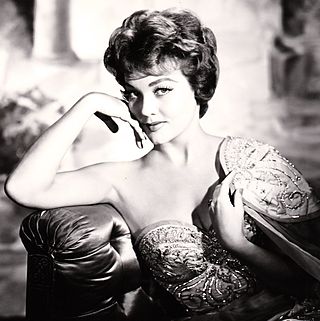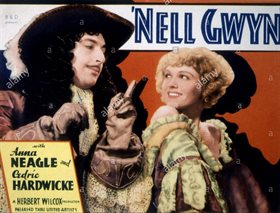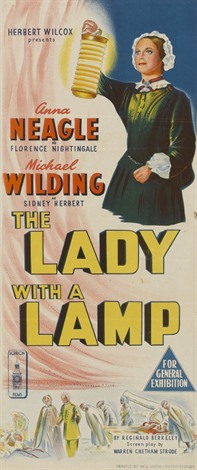
Dame Florence Marjorie Wilcox, known professionally as Anna Neagle, was an English stage and film actress, singer, and dancer.

Odette is a 1950 British war film based on the true story of Special Operations Executive French agent, Odette Sansom, living in England, who was captured by the Germans in 1943, condemned to death and sent to Ravensbrück concentration camp to be executed. However, against all odds she survived the war and testified against the prison guards at the Hamburg Ravensbrück trials. She was awarded the George Cross in 1946; the first woman ever to receive the award, and the only woman who has been awarded it while still alive.

Spring in Park Lane is a 1948 British romantic comedy film produced and directed by Herbert Wilcox which starred Anna Neagle, Michael Wilding and Tom Walls. Part of a series of films partnering Neagle and Wilding, it was the top film at the British box office in 1948 and remains the most popular entirely British-made film ever in terms of all-time attendance. It was shot at the Elstree Studios of MGM British, with sets designed by the art director William C. Andrews. Some location shooting also took place in London.

Herbert Sydney Wilcox CBE was a British film producer and director.

King's Rhapsody is a musical with book and music by Ivor Novello and lyrics by Christopher Hassall.

Patrice Wymore Flynn was an American film, television and stage actress of the 1950s and 1960s, known for her marriage to Errol Flynn.

Derby Day is a 1952 British drama film directed by Herbert Wilcox and starring Anna Neagle, Michael Wilding, Googie Withers, John McCallum, Peter Graves, Suzanne Cloutier and Gordon Harker. An ensemble piece, it portrays several characters on their way to the Derby Day races at Epsom Downs Racecourse. It was an attempt to revive the success that Neagle and Wilding had previously enjoyed on screen together. To promote the film, Wilcox arranged for Neagle to launch the film at the 1952 Epsom Derby.

These Dangerous Years is a 1957 British drama musical film directed by Herbert Wilcox and starring George Baker, Frankie Vaughan, Carole Lesley, Thora Hird, Kenneth Cope, David Lodge and John Le Mesurier. It was written by Jack Trevor Story, and was the first of three films Wilcox made with Vaughan.

The Lady Is a Square is a black and white 1958 British comedy musical film directed by Herbert Wilcox and featuring Anna Neagle, Frankie Vaughan and Janette Scott.

Rocky Mountain is a 1950 American Western film directed by William Keighley and starring Errol Flynn. It also stars Patrice Wymore, who married Flynn in 1950. The film is set in California near the end of the American Civil War.
Goodnight, Vienna is a 1932 British musical film directed by Herbert Wilcox and starring Jack Buchanan, Anna Neagle and Gina Malo. Two lovers in Vienna are separated by the First World War, but are later reunited.

Nell Gwyn is a 1934 British historical drama film directed by Herbert Wilcox and starring Anna Neagle, Cedric Hardwicke, Jeanne de Casalis, Miles Malleson and Moore Marriott. The film portrays the historical romance between Charles II of England and the actress Nell Gwyn. In the opening credits, the dialogue is credited to "King Charles II, Samuel Pepys and Nell Gwyn" with additional dialogue by Miles Malleson. It was also released as Mistress Nell Gwyn.

Piccadilly Incident is a 1946 British drama film directed by Herbert Wilcox and starring Anna Neagle, Michael Wilding, Coral Browne, Edward Rigby and Leslie Dwyer. It was written by Nicholas Phipps based on a story by Florence Tranter.

The Heart of a Man is a 1959 British drama film directed by Herbert Wilcox and starring Frankie Vaughan, Anne Heywood and Tony Britton. A millionaire in disguise gives a young man money to help him pursue his singing career.

No Time for Tears is a 1957 British drama film directed by Cyril Frankel in CinemaScope and Eastman Color and starring Anna Neagle, George Baker, Sylvia Syms and Anthony Quayle. It was written by Anne Burnaby and Frederix Gotfurt. The staff at a children's hospital struggle with their workload.

Wonderful Things! is a 1958 British comedy romance film directed by Herbert Wilcox and starring Frankie Vaughan, Jocelyn Lane and Wilfrid Hyde-White. It was written by Jack Trevor Story. Two fishermen brothers clash over the love of a woman.

The Lady with a Lamp is a 1951 British historical drama film directed by Herbert Wilcox and starring Anna Neagle, Michael Wilding and Felix Aylmer. The film depicts the life of Florence Nightingale and her work with wounded British soldiers during the Crimean War. It was shot at Shepperton Studios outside London. Location shooting took place at Cole Green railway station in Hertfordshire and at Lea Hurst, the Nightingale family home, near Matlock in Derbyshire. The film's sets were designed by the art director William C. Andrews. It is based on the 1929 play The Lady with a Lamp by Reginald Berkeley.

My Teenage Daughter is a 1956 British drama film directed by Herbert Wilcox and starring Anna Neagle, Sylvia Syms and Norman Wooland. The screenplay concerns a mother who tries to deal with her teenage daughter's descent into delinquency. It was intended as a British response to Rebel Without a Cause (1955). It was the last commercially successful film made by Wilcox.

Lilacs in the Spring is a 1954 British musical film directed by Herbert Wilcox and starring Anna Neagle, Errol Flynn and David Farrar. The film was made at Elstree Studios with sets designed by the art director William C. Andrews. Shot in Trucolor it was distributed in Britain by Republic Pictures. It was the first of two films Neagle and Flynn made together, the other being King's Rhapsody. It was released in the United States as Let's Make Up.
William C. Andrews was a British art director who designed film sets for a number of productions. During the 1940s he frequently worked for producer Herbert Wilcox. Later in his career he was generally credited as Bill Andrews.


















